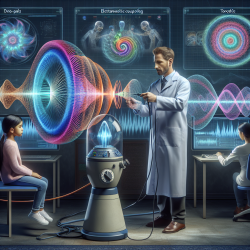Introduction
In the ever-evolving field of speech-language pathology, practitioners are constantly seeking innovative approaches to enhance therapeutic outcomes. Recent advancements in the understanding of polar-toroidal coupling in ferroelectric composite nanowires offer intriguing possibilities for improving electromechanical responses, which could be adapted to benefit therapeutic practices. This blog explores the implications of this research for speech-language pathologists and encourages further exploration into how these findings might be applied in clinical settings.
Understanding Polar-Toroidal Coupling
The study titled "Large and Tunable Polar-Toroidal Coupling in Ferroelectric Composite Nanowires toward Superior Electromechanical Responses" delves into the complex interactions within (BaTiO3)m/(SrTiO3)n nanowires. These interactions result in a variety of dipole states, including purely polar, purely toroidal, and mixed states, which are influenced by factors such as temperature and external electric fields.
The ability to control these states through external stimuli presents a unique opportunity for cross-disciplinary applications, including the field of speech-language pathology. The enhanced electromechanical responses observed in these nanowires suggest potential for developing more responsive therapeutic tools and devices.
Implications for Speech-Language Pathology
While the direct application of polar-toroidal coupling in speech-language pathology may not be immediately apparent, the underlying principles of enhanced responsiveness and adaptability are highly relevant. Here are a few ways in which these concepts could be explored further:
- Development of Adaptive Devices: Utilizing the principles of tunable electromechanical responses, speech-language pathologists could collaborate with engineers to develop adaptive communication devices that respond dynamically to the needs of the user.
- Enhanced Biofeedback Tools: The sensitivity of these nanowires to external fields could inspire the creation of biofeedback tools that provide real-time feedback to clients, aiding in more effective therapy sessions.
- Research and Development: Encouraging further research into the application of these findings within speech-language pathology could lead to groundbreaking advancements in therapy techniques and tools.
Encouraging Further Exploration
To truly harness the potential of polar-toroidal coupling, collaboration between speech-language pathologists, engineers, and researchers is essential. By fostering a multidisciplinary approach, we can explore innovative solutions that improve therapeutic outcomes for children and adults alike.
Practitioners are encouraged to delve deeper into the original research and consider how these findings might inspire new methodologies or tools within their practice. By embracing data-driven decisions and a commitment to continuous learning, we can pave the way for transformative changes in speech-language pathology.
Conclusion
The exploration of polar-toroidal coupling in ferroelectric composite nanowires offers exciting possibilities for enhancing electromechanical responses. By considering how these principles can be adapted to speech-language pathology, practitioners can contribute to the development of innovative therapeutic tools and techniques. For those interested in exploring this research further, the original paper can be accessed through the following link: Large and Tunable Polar-Toroidal Coupling in Ferroelectric Composite Nanowires toward Superior Electromechanical Responses.










